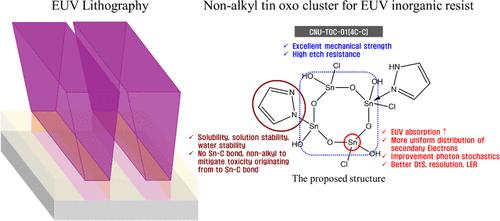非烷基锡氧簇的合成、表征及其在EUV光刻中高吸收系数耐蚀无机抗蚀剂的应用
IF 4.7
2区 化学
Q1 CHEMISTRY, INORGANIC & NUCLEAR
引用次数: 0
摘要
我们介绍了一种新型的非烷基锡氧簇CNU-TOC-01(4C-C),它是用SnCl2、H2O和吡唑通过回流溶液反应合成的,它允许规模化生产和分子定制。利用场解吸-飞行时间质谱(FD-TOF MS)和小角x射线散射(SAXS)表征了CNU-TOC-01(4C-C)为环状团簇,分子式为Sn4Cl3(C3N2H4)(C3N2H3)H4O8。SAXS测量的簇大小为11.6 Å,量子化学计算的长度估计为11.1 Å。合成材料的极紫外线性吸收系数为20.7 μm-1。在EUVL和电子束光刻(EBL)上的初步应用获得了精细的线条和空间图案,优化后具有超精细分辨率的潜力。CNU-TOC-01(4C-C)的高耐蚀性强调了其作为未来光刻应用的先进抗蚀剂材料的卓越适用性。本文章由计算机程序翻译,如有差异,请以英文原文为准。

Synthesis and Characterizations of a Nonalkyl Tin Oxo Cluster and its Application as High EUV Absorption Coefficient and Etch Resistant Inorganic Resist for EUV Lithography
We introduce a novel nonalkyl tin oxo cluster, CNU-TOC-01(4C–C), synthesized through a reflux-based solution reaction using SnCl2, H2O, and pyrazole, which permits scalable production and molecular customization. Using field desorption-time-of-flight mass spectrometry (FD-TOF MS) and small-angle X-ray scattering (SAXS), CNU-TOC-01(4C–C) is characterized as a cyclic cluster with the molecular formula Sn4Cl3(C3N2H4)(C3N2H3)H4O8. The cluster size was measured to be 11.6 Å by SAXS and estimated to be 11.1 Å lengthwise in quantum chemical calculation. The synthesized material exhibits an extreme ultraviolet (EUV) linear absorption coefficient of 20.7 μm–1. Initial application in EUVL and electron beam lithography (EBL) achieved fine line and space patterns with the potential for ultrafine resolutions upon optimization. CNU-TOC-01(4C–C)’s high etch resistance underscores its exceptional suitability as an advanced resist material for future lithographic applications.
求助全文
通过发布文献求助,成功后即可免费获取论文全文。
去求助
来源期刊

Inorganic Chemistry
化学-无机化学与核化学
CiteScore
7.60
自引率
13.00%
发文量
1960
审稿时长
1.9 months
期刊介绍:
Inorganic Chemistry publishes fundamental studies in all phases of inorganic chemistry. Coverage includes experimental and theoretical reports on quantitative studies of structure and thermodynamics, kinetics, mechanisms of inorganic reactions, bioinorganic chemistry, and relevant aspects of organometallic chemistry, solid-state phenomena, and chemical bonding theory. Emphasis is placed on the synthesis, structure, thermodynamics, reactivity, spectroscopy, and bonding properties of significant new and known compounds.
 求助内容:
求助内容: 应助结果提醒方式:
应助结果提醒方式:


